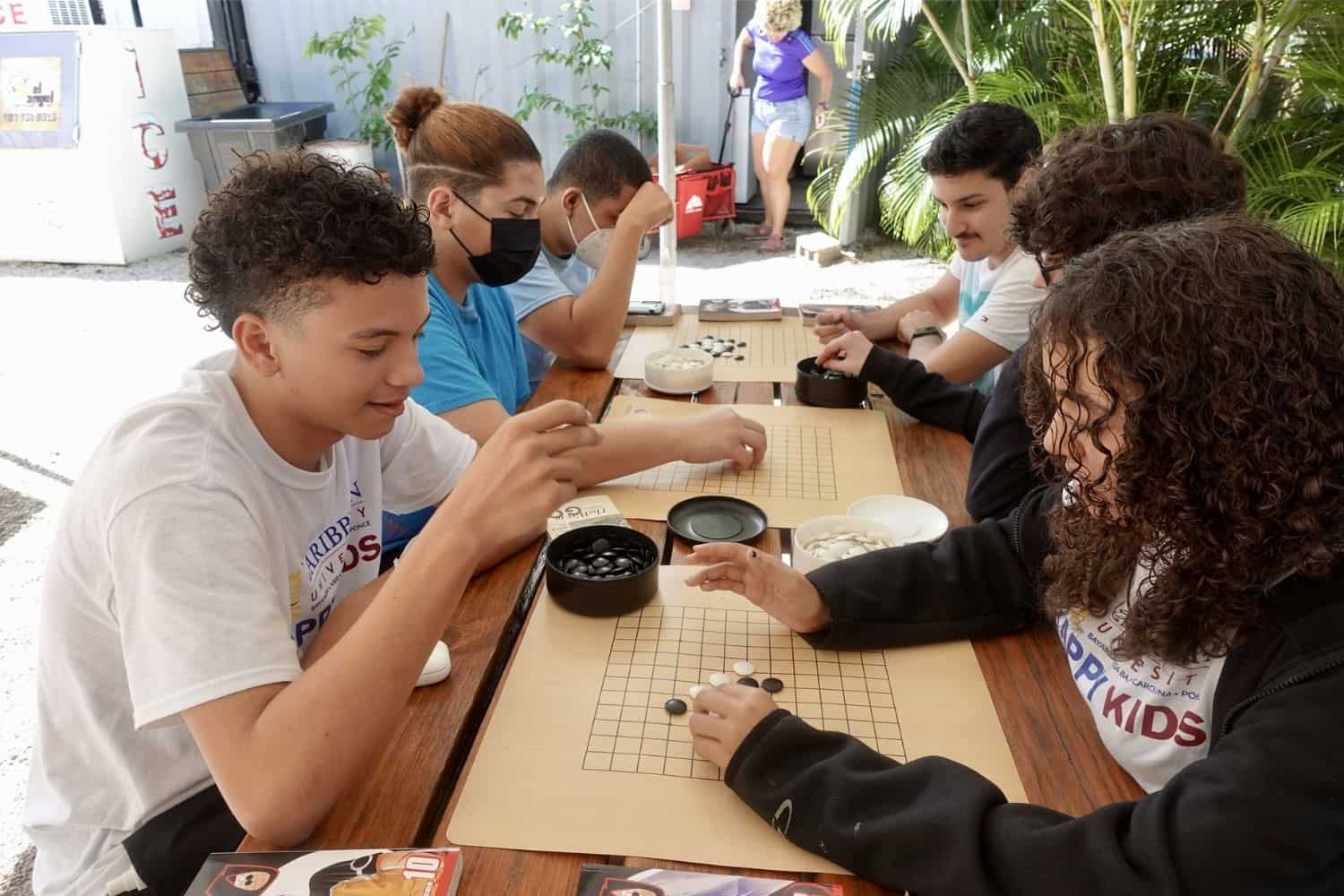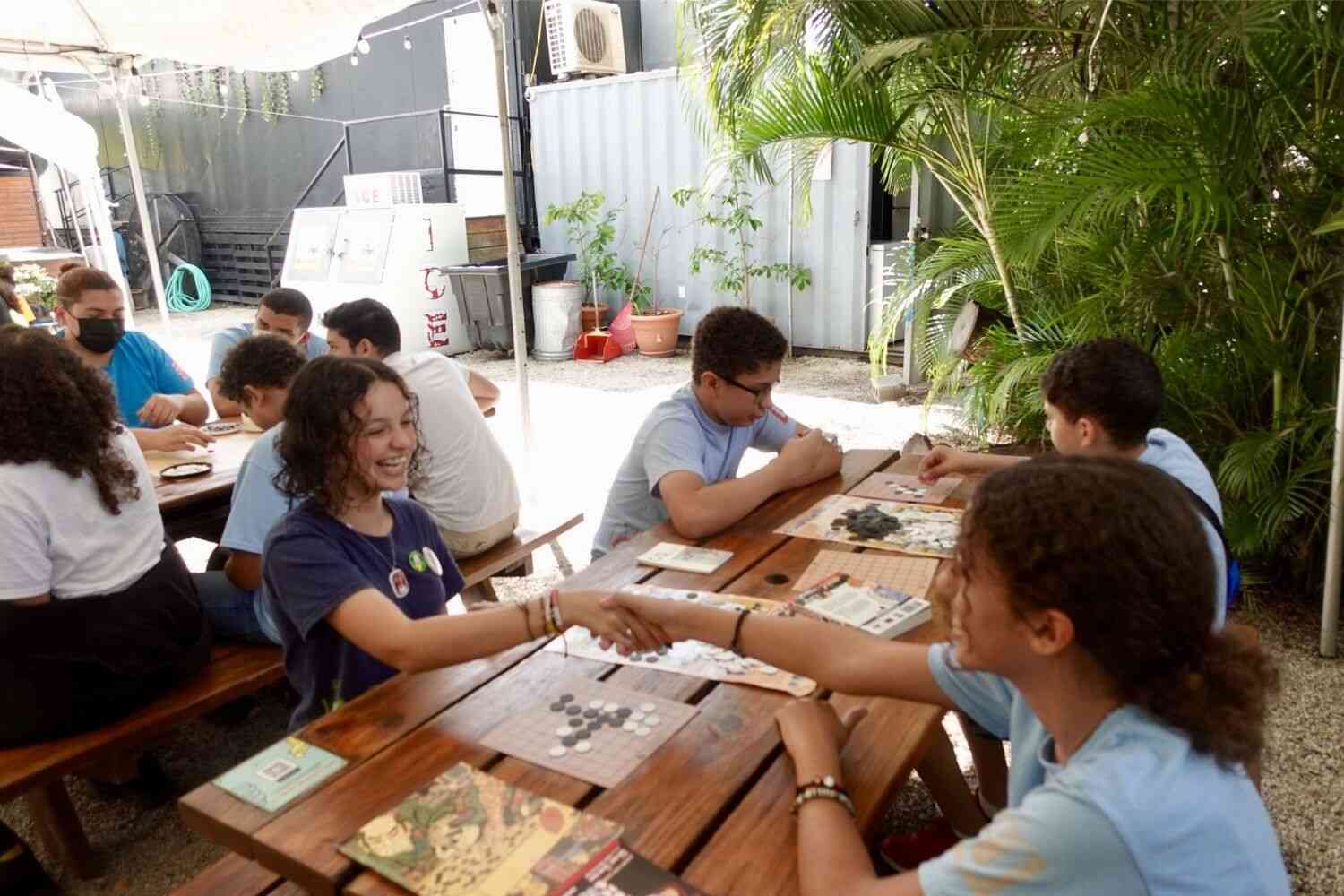Learn how to play Gomoku – one of the oldest and most tactical Japanese board games. In this guide, you’ll find an introduction to the game, its rules, and strategies that will help you become a true master!
How to Play Gomoku
Are you looking for more of a challenge than tic-tac-toe but not quite ready to take on the complexity of chess? Gomoku might be the perfect game for you.
This classic two-player strategy game, also known as “Five in a Row” or “Gobang,” has been around since the 16th century and is still very popular today. In this blog post, we’ll explain how to play Gomoku and give you some great tips so that you can become an expert player!
What Is Gomoku?

Similar to tic-tac-toe but with more complexity, Gomoku is best played on a standard Go board. But don’t worry, you can also enjoy it on the go with just a piece of graph paper and a pen!
Using black and white stones on a grid, the goal of Gomoku, also known as Five in a Row, is to get five of your stones in a row horizontally, vertically, or diagonally. And here’s the exciting part – you can capture your opponent’s stones to win the game!
Originating in ancient Japan, Gomoku is popular in Asian cultures and goes by different names like Gobang, Igo, and Ponukumu. So how do you prefer to play? Do you enjoy the traditional experience with paper and pencils, or do you prefer the convenience of an online or phone app?
No matter how you choose to play, Gomoku is a simple yet challenging game that anyone can enjoy. Next time you’re looking for a fun board game to play with friends or family, give Gomoku a try and discover the excitement for yourself!
Gomoku’s Origin
Gomoku, a game invented by an Italian named Edmondo de Acimis between 1890 and 1920, has an intriguing backstory behind its name. There are two theories about its origins.
According to historical records, Gomoku can be traced back to the mid-1700s during the Edo period in Japan. The game gained popularity through the skills of Kuwanaya Buemon, a merchant who frequented the Nijō family. By the late Edo period, books on gomoku had been published, with the earliest verified book being the Gomoku Jōseki Collection in 1856.
The name “gomoku” comes from the Japanese language, where it is known as “gomokunarabe.” In Japanese, go means five, moku is a counter word for pieces, and narabe means line-up. The game is also known as Wuziqi in China and omok in Korea, with similar structures and origins as the Japanese name.
In the nineteenth century, the game made its way to Britain, where it was known as Go Bang, a variation of the Japanese word goban, which originated from the Chinese term k’i pan (go-board).
Alternatively, some believe that Gomoku evolved from a Buddhist game played around 1000 AD, which involved placing stones at intersections of lines within specific boundaries, similar to tic tac toe.
How to Play Gomoku?
Step 1:
In the game of Gomoku, players are required to divide the black and white pieces evenly. The pieces, also known as stones, are circular. One player will receive all the black pieces, while the other player will receive all the white pieces.
Additionally, it is worth noting that Gomoku pieces are identical to Go pieces. Although the two games differ in gameplay, it is possible to play Gomoku using a Go set if desired.
Get ready to engage in a strategic battle of wits with this exciting game of Gomoku!
Step 2:
Get the game started with a black stone. As per tradition, the player using the black stones starts the game by placing one of their pieces on the board. Stones are positioned at the intersections formed by the grid of lines on the board, not inside the squares.
In the standard version of Gomoku, you have the freedom to place your stone at any intersection during your turn.
Once a piece is placed on an intersection, it cannot be moved for the duration of the game.
Interestingly, it has been proven mathematically that if the black player plays optimally, they will always win in this standard game beginning. However, in real-life gameplay, different skill levels between players often lead to different outcomes.
Step 3:
In Gomoku, two players take turns placing their stones on the board. The first player starts by placing a black stone, followed by the second player placing a white stone.
During tournaments, the duration of each turn is typically tracked using chess clocks. The standard time limit for most tournaments is 10 minutes per player for each game.
Step 4:
Win the game by getting 5 pieces in a row. Your goal is to be the first player to form an unbroken line of 5 of your stones. The line can be horizontal, vertical, or diagonal.
In Gomoku, the standard version requires winning lines to be exactly 5 stones and not more. Rows with 6 or more pieces are called “overlines” and are not counted as winning lines.
Mastering the Art of Gomoku: Strategies for Victory

Unlock the potential of your mind with the strategic game of Gomoku. This guide is designed to help you navigate the challenging moves of the game and emerge victorious. With some practice and the right strategies, you can conquer the Gomoku board.
To ensure your success, we have divided the playing strategies into three stages.
#1 Preparation
Know your opponent: Before engaging in a live Gomoku game, gather as much information as possible about your opponent. Learn about their game history, theoretical knowledge, personality, and mental strength. Seek advice from players who are familiar with your opponent. This knowledge will give you an edge.
Test Your Skills: Challenge yourself by playing against more experienced players. Engaging with stronger opponents will push the limits of your mind and help you improve. Avoid playing weaker players exclusively, as they won’t offer the same level of challenge.
Study the greats: Analyze the games of skilled players, observing not just their moves but also trying to understand the reasoning behind each move. Challenge yourself to come up with even better moves for future positions.
Believe in Yourself: When training, focus on outplaying your opponent rather than relying on unfamiliar openings or schemes. Develop the mindset that you are a superior player. This approach is not only satisfying but also contributes to your overall growth.
Address Your Weaknesses: Identify your weaknesses, such as theoretical knowledge, positional game, or slow thinking. Dedicate time to improving these areas through targeted training. By doing so, you will prevent your opponents from exploiting your flaws.
Seek the thrill of live play: Participating in live games provides a whole new level of excitement, tension, and emotions compared to online games. Embrace the intensity offered by real-time interactions on the board. This practice will enhance your performance and prepare you for live tournaments.
By following these strategies and dedicating yourself to the game, you can become a Gomoku master. Prepare, practice, and play to win!
#2 During the game
Prioritize Blocking: Always prioritize blocking your opponent’s potential four-in-a-row formations before making any move. Don’t worry about the immediate impact on the board; instead, focus on preventing your opponent from gaining an advantage. Once you’ve blocked their potential win, then consider your next move.
Utilize Your Opponent’s Time: Use your opponent’s turn to think about your moves. This is especially important if you find yourself running short on time. By strategizing during their turn, you can gain a significant advantage over your opponent.
Always evaluate the position after your opponent’s move before making your own: Take a moment to double-check your planned move and ensure it aligns with your strategy. Stick to your game plan throughout the match.
Plan Ahead: Develop a game plan before starting the match and stick to it throughout. Anticipate your opponent’s preferences and adjust your strategy accordingly. For example, if your opponent prefers to attack, allow them to do so while maintaining control of the positions. Eventually, they will run out of options, and you can launch your attack.
Adapt When Necessary: Be flexible and willing to adjust your strategy as the game progresses. However, each move must still align with your new plan. Stay focused and execute your actions accordingly.
Think Beyond the Present: Consider the future development of the game and look for moves that will set you up for success in upcoming positions.
Maintain Focus during Long Games: In longer live games, find ways to relax your mind while your opponent is on the clock. It’s challenging to concentrate for extended periods, so take breaks and divert your attention elsewhere. This can include taking a walk or observing other games.
Embrace Creativity: Don’t be afraid to experiment with new moves during your turn. While sticking to your usual strategies is important, occasionally introducing unexpected moves can surprise your opponent and inject freshness into the game.
Prioritize the First Ten Moves: Pay special attention to and invest more time in the early stages of the game. These initial moves often set the tone for the rest of the match. Even if you’re a highly skilled player, a mistake at the start can be difficult to recover from.
Prepare Mentally and Physically: Ensure you’re mentally and physically prepared for each game. Focus solely on the match and set aside any daily problems. Get enough rest, eat well, and prioritize self-care. These factors can have a significant impact on your mood and overall performance.
By following these strategies, you can enhance your Gomoku gameplay and increase your chances of achieving victory.
#3 After the Game

Remember the real key to success lies in embracing the spirit of the game. Respect your opponent, savor the beauty of each move, and always play fair.
In Gomoku, it’s not just about winning – it’s about enjoying the game to its fullest. By embodying true sportsmanship, you not only show respect to your opponent but also unlock the true essence of Gomoku.
But don’t be fooled by the notion of fair play. Fight with all your might and refuse to surrender any move or game. When your opponents realize that every encounter with you will be a grueling battle, they will subconsciously strive harder to defeat you.
Embark on a journey to become a Gomoku master, where victory is not only about skill but also about honorable and passionate gameplay.
Learning Different Opening Variations
#1 Pro Rules
Take your gameplay to the next level by trying the Pro rules. In this variation, the starting player (black) must strategically place their first stone on the middle intersection of the board. The second player (white) has the freedom to place their piece anywhere on the board. Black then must carefully position their second stone at least 3 intersections away from their first piece, creating a challenging dynamic. From there, the game proceeds as usual, with both players able to strategically place their stones at any open intersection.
These restrictions in the Pro variation lead to a more balanced and engaging game. By spacing black’s first two stones further apart, it becomes more difficult for them to secure a victory.
For an even greater challenge, consider trying the Long Pro variation. This variant follows the same rules as the Pro variation but requires the black’s second move to be at least 4 intersections away from their first piece, further expanding the strategic possibilities.
Elevate your Gomoku skills and embark on a thrilling journey with these innovative rule variations.
#2 Long Pro
The first player must strategically place their first stone in the center of the board, while the second player has the freedom to place their first stone anywhere. As the game progresses, the first player’s second stone must be positioned at least four intersections away from the first stone, with three empty intersections in between. These rules ensure a challenging and strategic gameplay experience.
#3 Swap variation
In a Gomoku game with Swap, the first player places 1 white and 2 black stones anywhere on the board. The second player then chooses who will play white and who will play black for the rest of the game. The player assigned white makes their move by placing a second white piece. The game continues as usual, with both players placing their stones on open intersections.
As the opening player doesn’t know which stones they will play, they should strategically position both colors equally.
While slightly more complex, the Swap opening rules create a fairer playing field compared to standard Gomoku, Pro, or Long Pro variations.
#4 Swap2
Master the Swap2 opening for a higher level of strategic gameplay. With the Swap2 variation, the first player strategically positions 1 white and 2 black stones on the board, following the same rules as the regular Swap opening.
The second player then has the option to choose their color or add 1 black and 1 white stone to the board. If the additional stones are placed, the first player has the privilege of selecting the colors for both players.
The game then progresses as usual, with white placing their next stone and both players taking turns until one player achieves a winning streak of 5 in a row.
Since 2008, the Swap2 rule has been embraced in the esteemed Gomoku World Championships. This opening rule is renowned for its unrivaled balance, making it a pinnacle of strategic gameplay.
Variants
Freestyle Gomoku
Experience the ultimate freedom to outwit your opponent in Freestyle Gomoku. This exciting variant removes all restrictions, allowing you to unleash your creativity and strategy. The goal is simple: create a line of five or more stones to claim victory. With each player taking turns to strategically place their stones, the battle for dominance is guaranteed to be intense.
Swap after the 1st Move
In China, a variant of the freestyle gomoku rule called “swap after 1st move” is gaining popularity. This exciting game can be played on either a 19×19 or 15×15 board.
The unique twist of this variant is that once the first player places a black stone on the board, the second player has the opportunity to swap colors. This rule adds an element of strategy and balance to the game, making it even more engaging.
After the color swap, the game continues as a regular freestyle gomoku match.
Experience the thrill and challenge of this variant that straightforwardly equalizes the advantage of black. Are you ready to master “Swap after the 1st Move” in freestyle gomoku?
Renju
Unlike traditional gameplay, Renju offers additional rules that level the playing field and create a more balanced experience.
Played on a 15×15 board, Renju incorporates the rules of three and three, four and four, and overlines, all designed to reduce the advantage of the first player, also known as the black player.
The rule of three and three prohibits moves that create two open rows of three stones simultaneously, ensuring a fair and competitive environment. Similarly, the rule of four and four forbids moves that result in two rows of four stones, whether they are open or not.
To further enhance fairness, overlines are implemented to prevent a player from winning if they manage to form a line of six or more stones. This ensures that victory is earned through skillful gameplay rather than exploiting loopholes.
Renju also incorporates various tournament opening rules, including the esteemed Soosõrv-8, which strives to uphold a consistent and internationally recognized standard of play.
Embark on a strategic journey with Renju and experience a game that encourages balance and skill.
Caro
Caro is loved by Vietnamese players worldwide. In Caro, the ultimate objective is to create an unbroken row of five stones, known as either an overline or an unbeatable winning line.
But here’s the catch: this winning line must remain unblocked at both ends, except when it comes to overlines. This unique rule adds an exciting balance to the game and gives the White player an extra edge in defensive maneuvers. Prepare for a thrilling and strategic battle in Caro!
Omok
Experience the excitement of Omok, a unique variation of Freestyle Gomoku. Set on a 19×19 board. Prepare to delve into the strategic realm of Omok as you navigate the intriguing “rule of three and three.”
Ninuki Renju
Ninuki Renju, also known as Wu, a captivating variant of the popular game. In this version, players can now capture their opponent’s stones! By strategically sandwiching a line of two stones lengthwise, a player can seize a pair of stones of the same color.
To win, a player must either create a flawless row of five stones or capture five pairs of their opponent’s stones. With a 15×15 board and the inclusion of rules like three and three and overlines, this game offers endless excitement.
Plus, even if a player forms a row of five stones, the game isn’t over if their opponent can still capture a pair across the line. Take your strategy to the next level with Ninuki Renju!
Pente
Pente is a captivating game that shares similarities with Ninuki-Renju. Played on a 19×19 board, Pente offers a unique custodial capture method while disregarding the rules of three and three, four and four, and overlines.
Conclusion
Gomoku is an easy and interesting game that can be enjoyed with family, friends, or even solo! If you’re looking for a creative way to pass the time, try playing a classic game of Gomoku. It will help bring some order and entertainment into any space in a few moves.
With its simple concept but deep levels of strategy, it’s bound to keep you and your opponents engaged for hours. So why not take a break from your everyday routine and dive into this challenging and stimulating game today?
Who knows, you may just find yourself stuck in this riveting world forever. So go ahead and get the gang together for some friendly competition – there’s nothing more enjoyable than huddling around a board game with close ones while scrumptious snacks line the table!
Don’t forget to tell us about your favorite strategies and techniques as we would love to hear them!
Thanks for reading our article How to Play Gomoku. If you want to know more information, visit our website here.
Read more:

